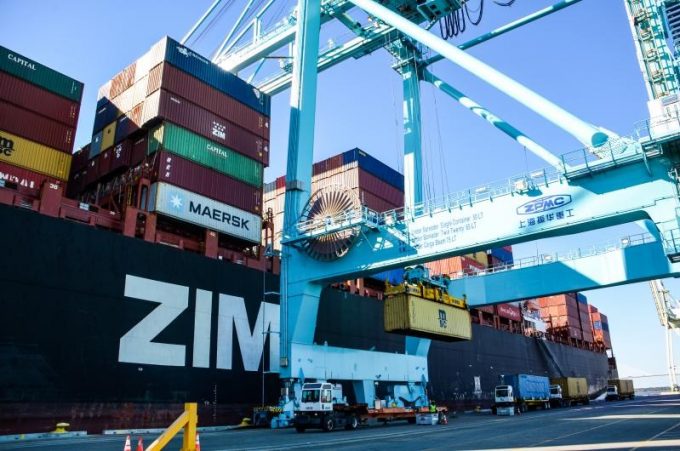CMA CGM Baltic feeder launch underlines role of Gdansk
The launch of a new Baltic feeder service from CMA CGM is cementing the role ...
CHRW: DOWN AND RIGHTLY SOXOM: SOLID AAPL: SUPPLY CHAIN PLANNING AAPL: INVENTORY FOCUSWMT: RESHORINGUPS: THE HANGOVERUPS: PRICING AMAZON RISKGXO: LUXURY PARTNERSHIP EXTENDEDUPS: SCS PERFORMANCEUPS: EFFICIENCY SOUGHTUPS: CHANGESUPS: OUTLOOKUPS: EARNINGS BEATTSLA: CFO ON TARIFFSTSLA: INVENTORY FOCUSUPS: TRADING UPDATE OUT SOONCHRW: NO SIGNS OF INFLECTION CHRW: EARNINGS BEAT
CHRW: DOWN AND RIGHTLY SOXOM: SOLID AAPL: SUPPLY CHAIN PLANNING AAPL: INVENTORY FOCUSWMT: RESHORINGUPS: THE HANGOVERUPS: PRICING AMAZON RISKGXO: LUXURY PARTNERSHIP EXTENDEDUPS: SCS PERFORMANCEUPS: EFFICIENCY SOUGHTUPS: CHANGESUPS: OUTLOOKUPS: EARNINGS BEATTSLA: CFO ON TARIFFSTSLA: INVENTORY FOCUSUPS: TRADING UPDATE OUT SOONCHRW: NO SIGNS OF INFLECTION CHRW: EARNINGS BEAT

Israeli carrier Zim achieved the biggest jump in average vessel capacity among the top ten global carriers in the past year, with growth of 30.8%.
Zim’s chartering strategy of replacing smaller vessels with larger LNG-powered tonnage on the Asia-US east coast tradelane enabled it to tap into the lucrative spot market and help follow a loss-making 2023 with a very respectable $655m net profit in the first half of this year.
Indeed, Zim makes no secret of having targeted spot cargo rather than long-term contract business to improve its bottom line, and during its Q2 earnings call last week, president and CEO Eli Glickman said Zim’s strategic decision to increase spot market exposure in the transpacific trade “enabled us to capture significant upside in a rate environment that has been elevated for longer than anticipated”.
According to an Alphaliner survey, Zim, MSC and CMA CGM were the only three carriers to record an average vessel capacity increase above the industry par of 3.5% in the past 12 months. MSC, the world’s biggest container line increased the average capacity of its vessels by 5.8%, while the French carrier saw its average rise 5.3%.
The consultant’s latest data shows the current cellular containership fleet at 6,278 vessels, with a total capacity of 30.2m teu, representing an average vessel size of 4,809 teu.
“For Haifa-based Zim, the increase from 4,395 teu in August 2023 to the current 5,748 teu coincides with a 25% fleet growth in the same period,” said Alphaliner.
“The carrier’s fleet counts fewer units than a year ago, but the line has replaced many classic panamax ships it had on charter with 5,300 teu to 7,900 teu newbuildings.”
Moreover, between February 2023 and April this year, Zim took delivery of ten 15,248 teu neo-panamax LNG-powered vessels, which it has deployed on its Zim Container Pacific (ZPC) Asia-USEC service.
Meanwhile, HMM maintains its position as the carrier operating a fleet with the largest average capacity, at 10,983 teu, due to the fact that the South Korean line has 78% of its capacity concentrated on the Asia-Europe and transpacific trades.
This compares with Europe-based lines MSC, Maersk, CMA CGM and Hapag-Lloyd, which also operate regional and feeder services deploying smaller ships, thus bringing their average vessel size down.
Interestingly, Alphaliner notes that in the past year, Latin America-related services have seen the biggest increase across all tradelanes in average vessel sizes, at 4.7%.
“This is partly due to the fact that many 12,800 teu to 16,000 teu neo-panamax newbuildings have joined Asia-Latin America loops,” it explained.
Unsurprisingly, the biggest vessels are deployed between Asia and Europe, with more than 90% of all existing 18,000+ teu vessels operating between Asia and North Europe and the Mediterranean – although the average size of these vessels actually fell over the past 12 months.
“The average vessel size on this route currently stands at 14,655 teu, which is down 1.7% year on year, as some smaller ships have been added to cope with the longer sailing times around the Cape of Good Hope,” explained Alphaliner.
Comment on this article